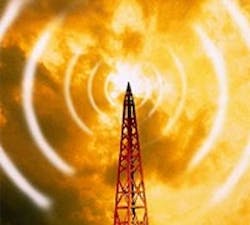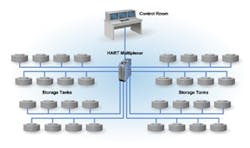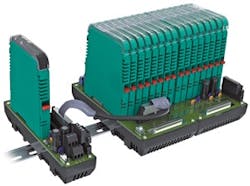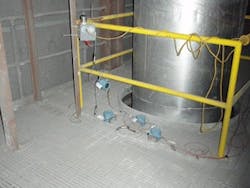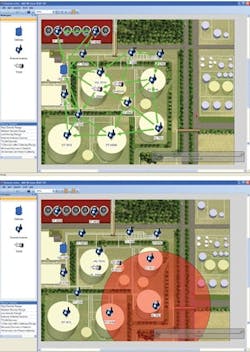Wired AND Wireless: What YOU Can Do With HART
For more than 20 years, HART Communication has been the fieldbus protocol that has been used the most. There are over 30 million installed HART-enabled devices, worldwide. That's more than double the number of devices installed by the next most common fieldbus. Why is this true? HART Communication has always been built on open standards. The IEC recognizes HART as part of its Industrial Communication Networks and Device Description Language (EDDL) standards. WirelessHART is built upon the IEEE 802.15.4 standard for low-power mesh radio networks. And WirelessHART itself is now an IEC standard, IEC62591. Another reason is that HART maintains the conventional 4-20mA signal, another international standard.
Typically, most users are familiar with the use of handheld communicators, such as the Rosemount 375 or 475 handheld communicators, or of PC-based communications software, such as ProComSol's Devcon2000 Smart Device Communicator. These devices are for manual programming or diagnostic checking of a plant's HART-enabled field devices.
And since WirelessHART is HART, anything you can do with a handheld or PC-based communicator, you can do wirelessly through WirelessHART.
There is so much more that you can do with your already existing HART-enabled devices, so let's look at what some end users have done.
How Wired HART Works
"HART" is an acronym for Highway Addressable Remote Transducer. The HART Protocol superimposes digital communication signals at a low level on top of the 4-20mA. This enables two-way field communication and makes it possible for additional information beyond just the normal process variable to be communicated to/from a smart field instrument, and there is no interference with the 4-20mA signal.
HART technology is a master/slave protocol, which means that a smart field device (slave) only speaks when spoken to by a master. The HART Protocol can be used in various modes such as point-to-point or multidrop for communicating information to/from smart field instruments to control systems. HART Communication occurs typically between a smart field device and a control or monitoring system. Best of all, HART Communication occurs using standard instrumentation-grade wire and using standard wiring and termination practices.
The HART protocol provides two simultaneous communication channels: the 4-20mA analog signal and a digital signal. The 4-20mA signal communicates the primary measured value (in the case of a field instrument) using the 4-20mA current loop—the fastest and most reliable industry standard. Additional device information is communicated using a digital signal that is superimposed on the analog signal.
The digital signal contains information from the device, including device status, diagnostics, additional measured or calculated values, etc. Together, the two communication channels provide a low-cost and very robust complete field communication solution that is easy to use and configure.
What You Can Do With Wired HART
Lower Your Maintenance Costs by 10%. Mitsubishi Chemical's HART Plant of the Year for 2009 is using the HART Communication capability of over 800 interoperable field devices integrated with its DCS and asset management systems through multiplexers and HART-enabled I/Os to access real-time continuous process variables and diagnostics. By accessing this real-time intelligent data Mitsubishi Chemical is able to diagnose abnormal process conditions and track equipment health 24 hours a day. As a result, peak production performance has improved, with an estimated operational savings for the plant of $20,000 to $30,000 USD per day.
How HART works: I/O to device
"Diagnostic parameters that help detect signs of an abnormal situation or degrading performance are difficult to obtain with simple handheld devices because they require a manual, time-consuming, step-by-step approach," says Takayuki Aoyama, team leader, instrumentation group, Mitsubishi Chemical. "HART technology made it possible to access this data without manual operation. This made it much easier for us to gather data and detect abnormal situations from field devices and has reduced maintenance costs by 10 percent."Manage Your Inventory. Tank level and inventory management is an ideal application for a HART multidrop network. The HART network digital update rate of two process variables per second is sufficient for many tank-level applications. A multidrop network provides significant installation savings by reducing the amount of wiring from the field to the control room, as well as the number of I/O channels required. In addition, many inexpensive process-monitoring applications are commercially available to further cut costs.
HART multiplexers are available from multiple vendors, such as Pepperl+Fuchs and Phoenix Contact.
HART multidrop enables cost-effective inventory control.
In fact, as Gerrit Lohmann, Pepperl+Fuchs' wireless product manager, points out, "When a HART 5 device is already installed and wired in the field, it does not initially make much sense to upgrade this device with a WirelessHART Adapter just to access the diagnostic data. Normally, a HART Multiplexer is the superior solution in terms of investment and operational costs. It has been shown that the hardware costs alone are significantly higher when implementing a WirelessHART solution verses a standard HART Multiplexer installation. Furthermore, the performance of a wired HART Multiplexer could be considered more stable when considering site constraints, distance limitations and network-related issues."Lohmann says, "With a HART Multiplexer, a short process shutdown will probably be required during the installation."
He goes on to note that there are advantages to using WirelessHART. "A plant shutdown is normally not required since the devices can be upgraded individually; however, the instrument may be offline for a short time during the instrument commissioning process. The existing wiring in the marshalling area is not affected, so during and after installation of the WirelessHART Adapters, the plant should continue to operate. There is normally enough space to mount the WirelessHART adapter on or near the field instrument, so installation is relatively easy. A HART Multiplexer requires control room cabinet space. This premium area is normally occupied with other existing hardware. As a result, the costs of an additional cabinet or junction box must be considered."
New Features in HART 7
HART 7, the first major upgrade of the HART Communication Protocol since 2001, includes significant new features and upgrades over HART 5 and HART 6. Bob Karschnia, Emerson Process Management's vice president of wireless, describes them. "HART 7 is an evolutionary step in HART technology that continues the tradition of adapting to changes in instrumentation design," he says.
HART multiplexer from Pepperl+Fuchs.
"HART 7 now allows eight variables to be communicated in a single message reflecting the trend for more multivariable devices that do calculations, as well as making measurements or actuating a valve," continues Karschnia. "As the importance of these additional variables has become evident, HART 7 now provides status indications for each one. To further support the multiple values provided by these products, the user can now simulate each variable providing the ability to do a "loop check" on both the analog and digitally communicated values. Data is now time-stamped. Although the wired devices may not have a real-time clock, they can still provide a relative time and eventually the control systems will become capable of synchronizing time across the wired HART devices, which will allow a much more accurate picture of plant performance. In the same way, system enhancements for HART 7 will be able to take advantage of condition-based reporting (report by exception), alert acknowledgement, data trending and other features that will appear in the HART devices."As Steve Todd, vice president of sales and marketing for Moore Industries-International, reports, "We anticipate HART being used more frequently in multidrop applications. Devices such as our TCM Multichannel Temperature Concentrator System have multiple channels and can have multiple devices on a single line. Devices like this take full advantage of the new features found in HART 7. The squawk-and-find device features will be very useful for configuring devices in multi-drop applications. The new sub-device feature will also be useful on our multichannel devices so that their internal data can be more logically organized. Exception-based reporting will improve the responsiveness of multidrop applications by reducing the data that must be transferred."
And of course, HART 7 includes WirelessHART.
The WirelessHART Standard
WirelessHART has already been used in a number of applications that would be difficult, if not impossible to do with wired HART. BP has expanded its Cherry Point refinery applications, installed Emerson's WirelessHART network throughout the tank farm in its R&D facility in Naperville, Ill., U.S., and is making installations at its other refineries around the world.
BP Cherry Point is a 225,000-bpd refinery located in northwestern Washington State in the U.S., and is the largest supplier of calcined coke to the aluminum industry. One out of every six aluminum cans is made using BP Cherry Point's calcined coke.
WirelessHART-enabled Smart Wireless transmitters on the refinery's calciner unit monitor bearing and calciner coke temperatures to help prevent fan and conveyor failure. Fans can cost up to $100,000 to repair, but more important, can be down for up to 10 days with associated production losses. The 15-transmitter wireless installation, originally done in 2006, continues to run reliably while eliminating operator rounds in the field.
Endress+Hauser has engineered a robust WirelessHART network that reliably communicates with 44 WirelessHART adapters and two Fieldgate gateways to adapt magnetic flow meters and pressure transmitters spread linearly over 2400-foot-wide leach field sections. These leach fields are regularly relocated, and the flexible WirelessHART redundant and mesh architecture accommodates the relocation with a minimum of effort.
Siemens, ABB and other vendors have also installed WirelessHART projects. It is estimated that there are already over 1400 installed WirelessHART-enabled field devices in the world.
MACTek has done one of the most innovative projects with WirelessHART to date, at Progress Energy in Crystal River, Fla. Dick Fletcher, of Progress Energy, says, "Our Performance Testing group needed a new data acquisition system. The data acquisition system needs to collect data from a variety of pressure and temperature transmitters. In addition, the system needs to be portable and flexible enough to operate with a constantly changing number of instruments and scan rates. The system needed to be portable, able to handle a variety of instruments (typically high-accuracy pressure and temperature transmitters), be easily configured, as every test is a different configuration, and interface with standard commercial instruments using standard protocols. In the long term, we wanted to broaden the scope of the data acquisition system from being simply for thermal performance testing to also include other testing, such as dye dilution flow testing and equipment diagnostics, and make the real-time test data available upon the corporate wide-area network."
Fletcher and his team decided on a multidrop configuration with existing wired HART transmitters, but connected to MACTek "Bullet" WirelessHART adapters, since each Bullet can handle up to eight HART transmitter inputs in multidrop mode.
"Far fewer cables have to be deployed now, and situations that placed cables at risk of damage (i.e., crossing roads) can now be handled by radio links instead," Fletcher reports. "Now, we are collecting the data in real time directly into an Excel spreadsheet via Matrikon Analytic's Excel Reporter plug-in for OPC data."
MACTek Bullet at Progress Energy
This application is a classic example of how WirelessHART and wired HART work together. Both are HART, and HART is robust enough to operate in the challenging environment of a power plant and have the devices and gateways continue to communicate reliably.How Do I?
Wired HART installations are very straightforward, whether they are 4-20mA home-runs or multidrop installations. WirelessHART is somewhat less so for two basic reasons. First, WirelessHART is new, and not everybody understands how to install and commission working (or wireless) systems, and second, the fact that it is a radio-based system means that WirelessHART is a little trickier to install than a standard
two-wire cable.
In a brownfield application, of course, you can apply trial and error like the Verizon man ("Can you hear me now?") and end up with a correctly sited WirelessHART device communicating to a gateway. In a greenfield application, things may be a little different.
Pepperl +Fuch's Gerrit Lohmann says, "There are some rules one has to consider when installing a WirelessHART Network," he says. "Generally, when the devices can ‘see' each other in a line of sight, they will communicate.
Emerson's AMS Snap-On tool for designing wireless networksThis would be the key when designing a network with no existing tanks or structures. Depending on the packing density of an area—which determines the maximum communication range—one can estimate if the devices can talk to each other over the distance. Finally, a check on the number of instrument ‘neighbors' is necessary. There should be two network neighbors at a minimum in a mesh network, while three is better. If a device has only one neighbor, or the distance between them exceeds the site constraints, a router may be required."
Endress + Hauser's vice president of solutions, Victor Wolowec, is not so sanguine. "A site survey of an existing facility should always be made before any WirelessHART device is installed. This is a standard part of Endress + Hauser's solution offering. The site survey determines the best position for the gateway relative to the devices and determines whether any repeaters are necessary. The adapter concept has a certain advantage here, since it allows the dipole antenna to be placed at some distance from the measuring point."
Vendors have started to include wireless network managers in their product portfolios for WirelessHART. Since late in 2008, Emerson Process Management has been including an AMS "Snap-On" that helps users design WirelessHART networks.
Bob Karschnia says, "AMS Wireless Snap-On is a tool that can be used with plot plans or simple scaled drawings to layout the network. AMS Wireless Snap-On can be used as a stand-alone application for site planning and in a real-time mode to monitor the network. This tool incorporates the best practices recommended for planning a network to minimize the chance that a device won't be able to join the network."
The self-organizing mesh capability of WirelessHART (IEC 62591) does not require a line of sight for a robust network. If devices do not join the network, there are several options, including changing the gateway placement, changing the height of the device to get above obstacles, using an antenna with a longer range or adding strategically placed repeaters. Karschnia says the AMS tool can help identify "stranded" devices and visualize how to remedy the issue.
"By either following these best practices or using the tool, EPCs can be assured that the wireless will work with no issue. More important, documents and procedures that are needed by EPCs are now available to help them execute projects with wireless content. The bottom line is that wireless has been made easy," Karschnia concludes.
With the new features of HART 7 and the wireless capabilities of WirelessHART, it is easy to see why HART remains the world's leading field communication protocol for the process industries.
HART Plant of the Year Award
The best candidates are plants that use the full range of HART capabilities—that have taken the capabilities of HART instruments beyond configuration and calibration, or are using real-time diagnostics and process variables of HART-enabled devices integrated with control, information and safety systems.
To nominate your plant, go to www.hartcomm.org.
